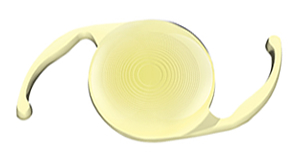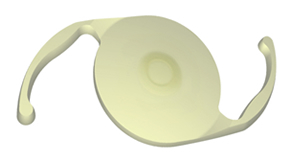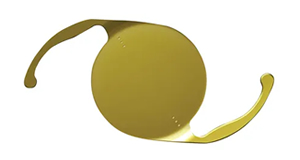During routine cataract surgery an implant is placed inside the eye in the same position as your original lens. This is for focusing light onto the retina at the back of your eye.
Before the operation I carry out tests on your eye called biometry, to work out what is the best strength of implant for your individual eye.
The aim of an implant is to reduce and in some cases eliminate the need for glasses.
Fixed focus implants
The majority of patients have a fixed focus lens placed inside their eye. This is usually fixed for distance so that you will still need glasses for reading. The lens I use most often is called an AcrySof® IQ. This has 2 benefits over other lenses.
Firstly, it has a yellow filter, which it is thought may help to protect against developing Macular Degeneration in the future.
Secondly, it has what is termed an aspheric design, which is more like a natural lens and may give very slightly better eyesight, particularly a measure of vision called contrast sensitivity which is a measure of how well you can discriminate shade of grey.
“Thank you very much for your treatment (cataract removal) of my left eye last Monday which appears to have been very successful. I know that it must be difficult dealing with a patient with hearing loss.” Mrs S, Bradford-on-Avon
Multifocal implants
Some implants act like bifocal or varifocal glasses and have either 2 or 3 focuses, 1 for distance and then either 1 for intermediate or 1 for intermediate/computer and 1 for near/reading. These lenses reduce the need for wearing glasses.
In scientific testing approximately 80% to 90% of patients with these implants did not need glasses at all. Most multifocal implants are made with concentric rings of different focuses. The junctions between these rings mean that some patients can notice haloes around streetlights or car headlights, and increased glare, which mean that they aren’t suitable if you do a lot of driving at night. These lenses can also correct astigmatism.
The most common trifocal lens I use is the Alcon PanOptix and the most common bifocal lens I use is the Alcon Vivity.

The Vivity lens only has distance and intermediate foci but has a different design to reduce haloes and glare. Another similar lens is the AMO Symfony.

Best results are achieved if both eyes have cataract surgery, and the brain has to learn to adjust to the implants, which takes several weeks.
Toric lenses (Astigmatism)
Most people have some degree of astigmatism. This is where the cornea at the front of the eye instead of being perfectly round is slightly rugby ball shaped. This means that a beam of light instead of being focused sharply onto the retina at the back of the eye has 2 different focus points. A moderate degree of astigmatism can affect your eyesight, but this can be corrected by a pair of glasses.
Astigmatism after cataract surgery can increase the need for glasses wearing after surgery. Minor degrees of astigmatism can be corrected by carrying out extra small cuts during the operation (Limbal Relaxing Incisions). More moderate degrees of astigmatism can be corrected by using an astigmatic implant called a Toric Intraocular lens.

Downloads
- Cataract – Patient Guide (PDF 498kb)
- PanOptix Vivity – Patient Brochure (PDF 709kb)
- Vivity Cataract – Patient Brochure (PDF 249kb)
A questionnaire about your visual expectations after cataract surgery; Please fill in and bring to your appointment.
